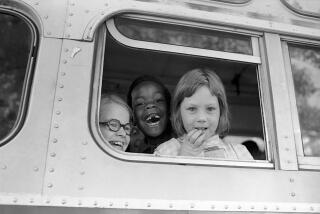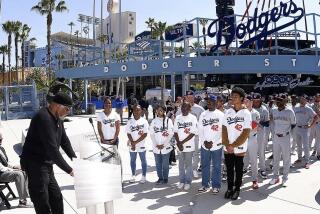Spottswood W. Robinson; Lawyer Challenged Segregation
- Share via
Spottswood W. Robinson III, a pioneering civil rights lawyer who argued one of the Supreme Court cases that led to the 1954 decision striking down school segregation, has died.
Robinson, 82, died Sunday at his Richmond, Va., home of what appeared to be a heart attack, relatives said.
In early 1951, Robinson, who would later become a federal judge, and his law partner in Richmond had no plans to attack school segregation in Virginia as unconstitutional. They were more focused on forcing local school systems to invest more in segregated black schools.
But that was before Barbara Johns, a high school junior, called their law office in April. She complained that nothing at her school--buses, textbooks, facilities--even approached the quality of those provided at white schools.
Robinson and law partner Oliver Hill filed suit on behalf of 100 parents of 450 students at Moton High School in Prince Edward County, Va., convinced that their only chance lay in getting the case before the U.S. Supreme Court.
The issues in that case and four others--including Brown vs. Board of Education--were decided in the high court’s historic 1954 Brown decision declaring “separate but equal” schools unconstitutional.
“Where one can ride on a bus, a train, or plane, or where one can live and rent or buy a house, or whether public education has to be given the same level to all people are basic issues,” former Virginia Gov. Douglas Wilder wrote in a tribute to Robinson last year. “Spottswood Robinson has been there . . . in his quiet, unassuming . . . way, charting and paving a path for countless Americans . . . who owe to him a great debt of gratitude.”
Robinson was born in Richmond on July 26, 1916, and attended Virginia Union University. He graduated from Howard University’s School of Law in 1939 with the highest grade-point average in its history.
He taught at Howard, where he later became dean of the law school, while practicing law part time. Robinson worked with Howard’s Charles Houston, considered the dean of civil rights lawyers, on Shelly vs. Kramer, the 1948 Supreme Court decision that outlawed restrictive covenants in real estate.
Robinson was also on the legal team that brought a case challenging racial segregation on Greyhound buses. And he was involved in a 1956 court battle against Virginia’s so-called NAACP Bills, a set of state laws attempting to hobble activities of the National Assn. for the Advancement of Colored People. The laws prohibited such activities as soliciting and contributing funds to pay for litigation involving race cases. A federal court eventually threw out the laws as unconstitutional.
In 1961, President John F. Kennedy named Robinson to the U.S. Commission on Civil Rights. He was appointed to the U.S. District Court for the District of Columbia three years later. Two years after that, President Lyndon B. Johnson made him the first African American to serve on the U.S. Court of Appeals for the D.C. circuit.
Robinson became chief judge in 1981 and retired in 1992.
He is survived by his wife, Marian; a son, Spottswood; a daughter, Nina R. Govan; and a sister.
The Associated Press contributed to this report.
More to Read
Sign up for Essential California
The most important California stories and recommendations in your inbox every morning.
You may occasionally receive promotional content from the Los Angeles Times.













